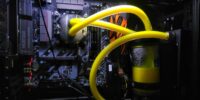Wi-Fi Vs. Ethernet: Comparing Network Connection Options
In today’s digital age, the demand for fast and reliable network connections is paramount. Two popular options for connecting devices to the internet are Wi-Fi and Ethernet. While both provide connectivity, they differ in terms of speed, stability, security features, range and coverage considerations, installation process, cost analysis, device compatibility and limitations, network congestion and interference.
This article aims to objectively compare these two network connection options.
Firstly, a comparison will be made regarding speed and stability. Wi-Fi offers convenience with its wireless nature but may have slower speeds due to signal interference or distance from the router. On the other hand, Ethernet provides a more stable connection as it relies on physical cables.
Next, we will explore the security features and vulnerabilities associated with each option. Additionally, we will delve into range and coverage considerations which can impact accessibility throughout a space.
Furthermore, this article will discuss installation processes for both Wi-Fi and Ethernet connections along with associated costs. Device compatibility and potential limitations will also be addressed.
Lastly, we will examine how network congestion and interference affect performance as well as future trends in network connections that could potentially revolutionize this field. By providing an unbiased analysis of these factors, readers can make informed decisions when choosing between Wi-Fi and Ethernet for their networking needs.
Key Takeaways
- Wi-Fi offers convenience but may have slower speeds and less stability compared to Ethernet.
- Ethernet provides a more stable connection with faster speeds ranging from 100 Mbps to 10 Gbps.
- Wi-Fi networks are susceptible to eavesdropping, while Ethernet requires physical access to compromise.
- Wi-Fi installation involves configuring wireless routers and individual device setups, while Ethernet requires physical wiring connections.
Speed and Stability Comparison
The comparison between the speed and stability of Wi-Fi and Ethernet connections is crucial in determining the most efficient network connection option, evoking a sense of curiosity and desire for optimal performance in the audience.
In terms of speed, Ethernet connections have traditionally been faster than Wi-Fi due to their direct wired connection. With speeds ranging from 100 Mbps to 10 Gbps, Ethernet offers consistent and reliable high-speed internet access.
On the other hand, Wi-Fi connections are affected by various factors such as distance from the router, interference from other devices or walls, resulting in potential signal loss and slower speeds compared to Ethernet.
When it comes to stability, Ethernet connections are generally more stable as they are not susceptible to interference or signal degradation like Wi-Fi connections. However, advancements in technology have improved Wi-Fi stability significantly over time.
Ultimately, while both options offer different advantages and disadvantages when it comes to speed and stability, choosing between them depends on specific needs and preferences.
Security Features and Vulnerabilities
When analyzing the security aspects and potential vulnerabilities of different types of network connections, it becomes evident that a thorough examination is required.
Wi-Fi and Ethernet connections have distinct security features and vulnerabilities.
Wi-Fi networks are susceptible to eavesdropping, as the signals can be intercepted by unauthorized individuals within range. Encryption protocols such as WPA2 have been implemented to mitigate this risk, but they are not foolproof.
On the other hand, Ethernet connections provide a more secure option since they require physical access to the network infrastructure. However, if an attacker gains physical access to an Ethernet port or cable, they could potentially compromise the entire network.
Additionally, both Wi-Fi and Ethernet networks face threats from various malware attacks and hacking attempts, highlighting the importance of implementing robust security measures for all network connection options.
Range and Coverage Considerations
Range and coverage considerations play a significant role in determining the effectiveness and accessibility of different types of network connections, evoking an understanding of the crucial importance of these factors in enabling seamless communication and connectivity.
When comparing Wi-Fi and Ethernet connections, it is vital to assess their range limitations. Wi-Fi signals are susceptible to interference from physical barriers such as walls or furniture, resulting in reduced coverage within a given space. Additionally, the distance between the router and device can impact signal strength and stability.
Ethernet connections, on the other hand, provide a more reliable and consistent connection over longer distances without being affected by physical barriers or distance limitations. This makes Ethernet ideal for areas where strong signal coverage is required or when there are multiple devices that require high-speed connectivity simultaneously across a large area.
Installation and Setup Process
Installation and setup processes for different types of network connections involve various steps and configurations that need to be carefully followed in order to establish a seamless and efficient communication infrastructure.
When it comes to Wi-Fi, the installation process typically involves connecting a wireless router to an internet source, such as a modem, and configuring the router settings. This may include setting up a username and password for the network, choosing a channel, and adjusting security settings. Additionally, each device that will be connected to the Wi-Fi network needs to go through a setup process by selecting the network from available options and entering the appropriate credentials.
On the other hand, Ethernet installation requires physically connecting devices through Ethernet cables. This generally involves plugging one end of an Ethernet cable into a device’s Ethernet port and the other end into a router or switch. Unlike Wi-Fi, which relies on radio signals for communication, Ethernet provides a wired connection that is typically more stable and faster. However, this type of setup does require running cables throughout the desired areas where devices will be connected.
Both Wi-Fi and Ethernet have their own distinct installation procedures. While Wi-Fi requires configuring wireless routers and individual device setups wirelessly, Ethernet involves physical wiring connections between devices using cables. Each option offers its own advantages in terms of speed and stability depending on specific requirements.
Cost Analysis: Wi-Fi vs. Ethernet
In evaluating the cost of implementing network infrastructure, it is essential to consider the financial implications associated with choosing between wireless and wired connectivity solutions. While both Wi-Fi and Ethernet options require an initial investment, the long-term costs can vary significantly. Wi-Fi networks typically involve lower upfront costs as they eliminate the need for extensive cabling installation. However, ongoing expenses can arise from purchasing and maintaining access points, routers, and other necessary equipment. On the other hand, Ethernet connections generally have higher installation costs due to cable requirements but offer more stable and reliable connections with minimal maintenance needs. Additionally, Ethernet cables tend to be more durable and have a longer lifespan compared to wireless devices. A cost analysis table comparing these two options is presented below:
| Cost Factors | Wi-Fi | Ethernet |
|---|---|---|
| Initial Setup | Lower cost | Higher cost |
| Equipment | Moderate cost | Higher cost |
| Maintenance | Ongoing expense | Minimal expense |
Table: A comparison of cost factors between Wi-Fi and Ethernet network connections.
By carefully considering these factors, organizations can make informed decisions regarding their network connectivity options based on their specific budgetary constraints and requirements.
Device Compatibility and Limitations
In continuation with the cost analysis of Wi-Fi versus Ethernet, it is important to consider device compatibility and limitations associated with these network connection options.
While Wi-Fi offers convenience and flexibility by enabling wireless connectivity across various devices such as laptops, smartphones, and tablets, it may encounter limitations in terms of range and signal strength.
Additionally, certain older or specialized devices may not be compatible with Wi-Fi technology, necessitating the use of Ethernet connections.
On the other hand, Ethernet connections provide a reliable and stable network connection that can support high-speed data transfer without being affected by external factors like interference or obstacles.
However, Ethernet connections require physical cables which limit mobility compared to Wi-Fi.
Therefore, understanding device compatibility and limitations is crucial in choosing the most suitable network connection option for specific requirements.
Network Congestion and Interference
Network congestion and interference can significantly impact the performance and reliability of a wireless network, causing delays in data transmission and reduced signal strength. This is especially true in densely populated areas where multiple devices are connected to the same Wi-Fi network, leading to increased network traffic.
Interference from other electronic devices and physical barriers such as walls or furniture can also weaken the Wi-Fi signal. To mitigate these issues, it is recommended to:
-
Use an Ethernet connection for devices that require a stable and fast internet connection.
-
Optimize router placement to minimize obstructions and maximize coverage.
-
Choose a less crowded Wi-Fi channel to reduce interference from neighboring networks.
-
Upgrade to a dual-band router that operates on both 2.4 GHz and 5 GHz frequencies.
-
Employ Quality of Service (QoS) settings on the router to prioritize certain types of network traffic for better performance.
Future Trends and Advancements in Network Connections
Advancements in technology are constantly shaping the future of wireless connectivity, with emerging trends focusing on enhancing network performance, increasing data transfer rates, and improving overall user experience. One notable advancement is the introduction of Wi-Fi 6 (802.11ax) standard, which promises higher speeds and better efficiency compared to its predecessors. This new standard utilizes techniques like orthogonal frequency-division multiple access (OFDMA), multi-user multiple input multiple output (MU-MIMO), and target wake time (TWT) to reduce congestion and improve latency. Additionally, advancements in beamforming technology allow for more precise signal transmission and reception, resulting in improved coverage and reduced interference. Another trend is the adoption of mesh networking systems that use multiple interconnected access points to provide seamless coverage throughout a larger area. These advancements contribute towards creating a more reliable wireless network connection that can support the growing demand for high-speed internet access across various devices.
| Trend | Description |
|---|---|
| Wi-Fi 6 Standard | The latest Wi-Fi standard offering higher speeds and improved efficiency through techniques like OFDMA, MU-MIMO, and TWT. |
| Beamforming Technology | Enhances signal transmission by focusing it directly towards devices instead of broadcasting signals uniformly in all directions. |
| Mesh Networking Systems | Utilizes interconnected access points to extend coverage seamlessly over large areas without compromising on performance or reliability. |
| Internet of Things (IoT) Integration | Developments focused on integrating IoT devices into wireless networks for improved control, automation, and communication within smart environments. |
| 5G Connectivity | The next-generation cellular network technology that promises ultra-fast speeds and low latency for both mobile devices and fixed wireless connections in select areas. |
Frequently Asked Questions
Can I use both Wi-Fi and Ethernet connections simultaneously on my device?
Yes, it is possible to use both Wi-Fi and Ethernet connections simultaneously on a device. This allows for increased network speed and stability by utilizing the advantages of both wired and wireless connections.
Are there any health risks associated with using Wi-Fi or Ethernet connections?
There is no scientific evidence to suggest that using either Wi-Fi or Ethernet connections poses any significant health risks. Both options are considered safe for use in terms of potential negative effects on human health.
Can I connect multiple devices to a single Wi-Fi or Ethernet connection?
Multiple devices can be connected to a single Wi-Fi or Ethernet connection. This allows for simultaneous internet access and sharing of resources, but the number of devices that can be connected may depend on the capacity and limitations of the network.
How do I troubleshoot common connectivity issues with Wi-Fi or Ethernet?
To troubleshoot common connectivity issues with Wi-Fi or Ethernet, first check if the cables are properly connected. Then, ensure that the network settings are correctly configured and try restarting the router or modem.
Are there any data usage limitations or restrictions with Wi-Fi or Ethernet connections?
Both Wi-Fi and Ethernet connections do not have inherent data usage limitations or restrictions. However, the actual data usage may be influenced by factors such as internet service provider plans or network congestion.





